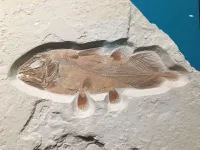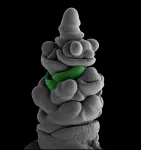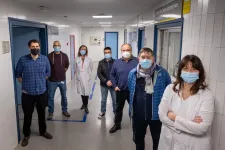Ultrabright dots see beyond skin deep
2021-02-16
(Press-News.org) A polymer that is custom designed to produce light that penetrates murky environments has shown promise in bioimaging trials, where it can detect nano-sized particles underneath the surface of realistic tissue models.
Recent studies have demonstrated that fluorescent probes -- light-emitting materials that attach to tiny targets such as cells -- are particularly useful for bioimaging when they radiate in the shortwave infrared (SWIR) region of the optical spectrum. Because this type of fluorescent light penetrates deeper into biological objects without being absorbed or scattered, SWIR probes can be spotted farther into tissue than conventional emitters. These features have enabled SWIR probes to capture high-resolution images of structures located deep within the body, such as brain tissue, without the hazards of x-rays.
Satoshi Habuchi and his colleagues are working to improve fluorescent imaging by expanding the type of probes capable of producing SWIR radiation. Currently, most bright SWIR emitters are either semiconductor quantum dots or rare-earth-doped nanoparticles that are unsuitable for many specimens because of their toxic side-effects. On the other hand, materials that are more biocompatible, such as organic dyes, are usually not intense enough to be seen inside tissue.
To resolve this issue, KAUST researchers turned to polymers having "donor-acceptor" structures, a layout where electron-rich components alternate with electron-poor portions along a conductive molecular chain. "This distribution promotes charge transfer along the polymer backbone, which is a very effective way to obtain SWIR light," explains Hubert Piwon?ski, the study's lead author.
The team chose two donor-acceptor polymers with ideal characteristics for SWIR emission and then developed a precipitation procedure that fused the compounds into tiny polymer spheres, or "dots", just a few nanometers wide. Optical characterizations revealed these materials had exceptionally bright SWIR emissions that were easily spotted in biological tissue models.
"Per volume, our particles have a brightness value larger than almost all other SWIR emitters reported so far," says Habuchi. "This enabled detection of nanometer-sized polymer dots in specimens one millimeter thick."
In addition, the new polymer dots that fluoresce only for a nanosecond can produce low-noise images with single-molecule sensitivity due to high throughput detection of emitted fluorescence. The ability to visualize single probes at fast acquisition rates could benefit researchers looking to capture processes in tissues and organs as they happen.
"There are huge opportunities for new probes and imaging modalities capable of addressing the dynamics of molecules in living systems, and our polymer dots are a big step toward single-particle tissue imaging," says Piwon?ski.
INFORMATION:
ELSE PRESS RELEASES FROM THIS DATE:
2021-02-16
Humans inhabit an incredible range of environments across the globe, from arid deserts to frozen tundra, tropical rainforests, and some of the highest peaks on Earth. Indigenous populations that have lived in these extreme environments for thousands of years have adapted to confront the unique challenges that they present. Approximately 2% of people worldwide live permanently at high altitudes of over 2,500 meters (1.5 miles), where oxygen is sparse, UV radiation is high, and temperatures are low. Native Andeans, Tibetans, Mongolians, and Ethiopians exhibit adaptations that improve their ability to survive such conditions. Andeans, for example, display increased chest circumference, elevated oxygen saturation, and a low hypoxic ventilatory response, enabling them to thrive at exceptionally ...
2021-02-16
New study from Warwick Medical School examined the effectiveness of three alternatives to CPR, concluding that none were beneficial
First comprehensive systematic review of evidence on precordial thump, percussion pacing and cough CPR - all of which have fallen out of routine practice
Precordial thump is often portrayed in television and film, and cough CPR misinformation circulates frequently on social media - but neither are effective
Reaffirms CPR as the 'gold standard' technique when assisting someone experiencing a cardiac arrest
A technique frequently portrayed in dramatic resuscitation scenes in television ...
2021-02-16
Scientists created a framework to test the predictions of biological optimality theories, including evolution.
Evolution adapts and optimizes organisms to their ecological niche. This could be used to predict how an organism evolves, but how can such predictions be rigorously tested? The Biophysics and Computational Neuroscience group led by professor Gašper Tkačik at the Institute of Science and Technology (IST) Austria has now created a mathematical framework to do exactly that.
Evolutionary adaptation often finds clever solutions to challenges posed by different environments, from how to survive in the dark depths of the oceans to creating intricate organs such as an eye or an ear. But can we mathematically predict these outcomes?
This is ...
2021-02-16
Fossilised remains of a fish that grew as big as a great white shark and the largest of its type ever found have been discovered by accident.
The new discovery by scientists from the University of Portsmouth is a species of the so-called 'living fossil' coelacanths which still swim in the seas, surviving the extinction that killed off the dinosaurs.
The discovery was purely serendipitous. Professor David Martill, a palaeontologist from the University's School of the Environment, Geography and Geosciences, had been asked to identify a large ...
2021-02-16
In plants, the "meristem" refers to a type of tissue comprising undifferentiated cells from which various other plant organs can develop through cell division and differentiation. These "plant stem cells" give rise to shoots, leaves and roots, but also spikes and flowers.
The research team including members of the Cluster of Excellence on Plant Sciences CEPLAS investigated the function of a gene responsible for the different spike forms of wheat and barley. This gene controls the activity of the spike and floret meristems and thus the number of spikelet ...
2021-02-16
The research team that developed a biosensor that first recorded that a distinct gradient of the plant growth hormone gibberellin correlated with plant cell size has now revealed how this distribution pattern is created in roots.
Starting when a plant embryo forms within a seed and continuing throughout the plant lifecycle, undifferentiated stem cells undergo radical transformations into specialised root, stem, leaf and reproductive organ cells. This transformation relies on a suite of molecules called phytohormones that, much like human hormones, can move between cells and tissues and trigger distinct biological processes across the bodyplan. While it was not known at the time, mutations involving the gibberellin class of ...
2021-02-16
PITTSBURGH, Feb. 15, 2021 - Why do patients who receive antipsychotic medications to manage schizophrenia and bipolar disorder quickly gain weight and develop prediabetes and hyperinsulemia? The question remained a mystery for decades, but in a paper published today in Translational Psychiatry, researchers from the University of Pittsburgh School of Medicine finally cracked the enigma.
Antipsychotic drugs, scientists showed, not only block dopamine signaling in the brain but also in the pancreas, leading to uncontrolled production of blood glucose-regulating hormones and, eventually, obesity and diabetes.
"There are dopamine theories of schizophrenia, drug addiction, depression and neurodegenerative disorders, and we are presenting a dopamine theory of metabolism," said lead ...
2021-02-16
For more than a decade, governments in countries across the world have made significant progress to expand their protected areas network to conserve the planet's biodiversity. According to a new study published in the journal Global Change Biology, the locations of these protected areas do not take into account the potential long-term effects of climate change in these protected areas.
Creating and managing protected areas, such as national parks, is key for biodiversity conservation. As the climate changes, however, species will disperse in order to maintain their specific habitat needs. Species that were in protected areas ...
2021-02-16
Almost half the patients admitted to an intensive care unit (ICU) require invasive mechanical ventilation (IMV), a medical procedure that guarantees a sufficient supply of oxygen to their organs and tissues. The therapy involves connecting patients to a machine that substitutes their spontaneous breathing. In recent months it has been in general use in intensive-care patients affected by COVID-19.
Although it can often save a patient's life, invasive mechanical ventilation is not risk-free: there can be accidental injury during intubation or extubation or the muscles ...
2021-02-16
A NEW study from the University of Chichester has shed light on how people coped psychologically with the sudden and life-changing disruption caused by COVID-19.
This new publication, by Chichester's Professor Laura Ritchie and PhD candidate Benjamin Sharpe, in collaboration with Professor Daniel Cervone of the University of Illinois at Chicago, provides a unique snapshot into people's understanding of their goals and self-beliefs amidst a shared, unexpected alteration of the daily landscape during lockdown.
Ritchie and colleagues collected their ...
LAST 30 PRESS RELEASES:
[Press-News.org] Ultrabright dots see beyond skin deep







